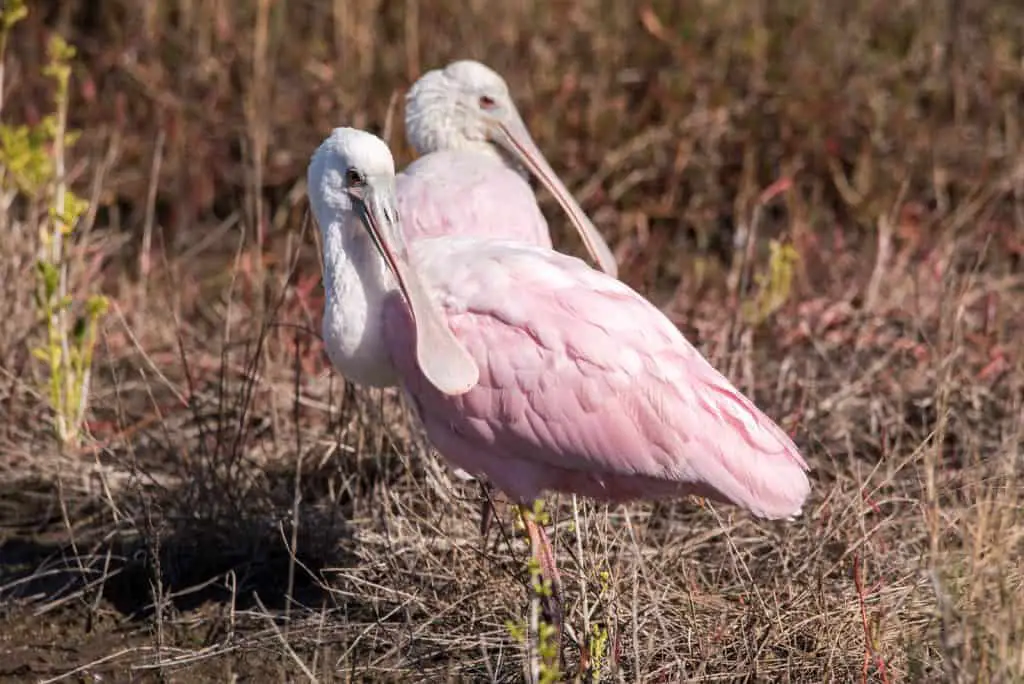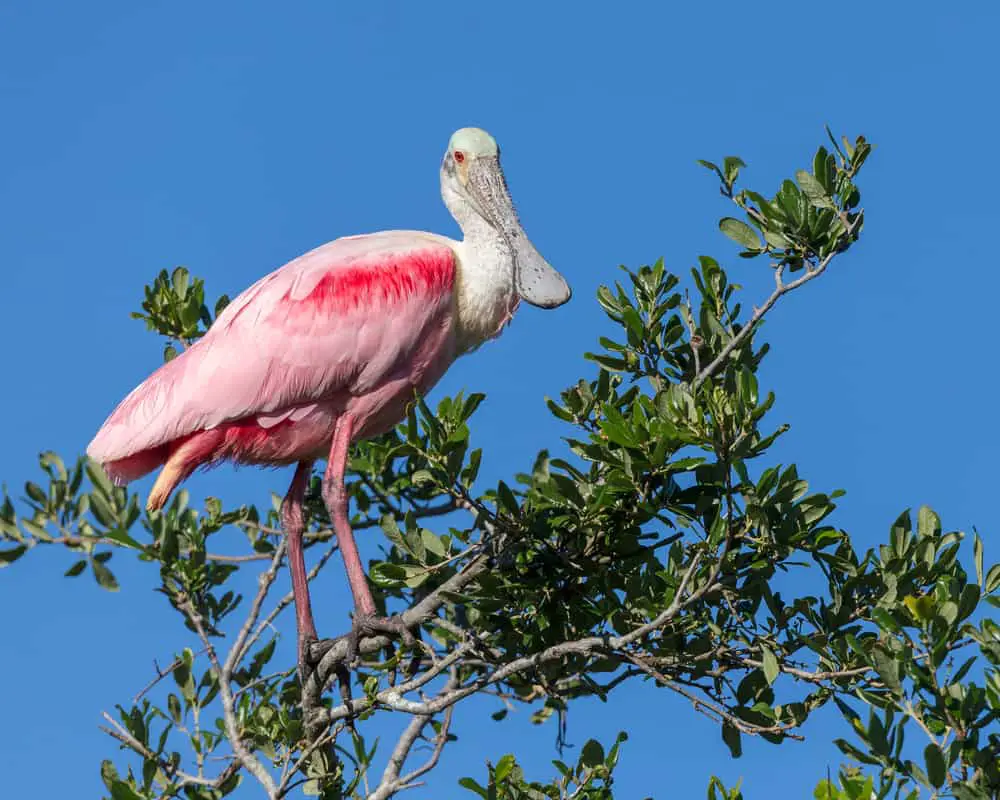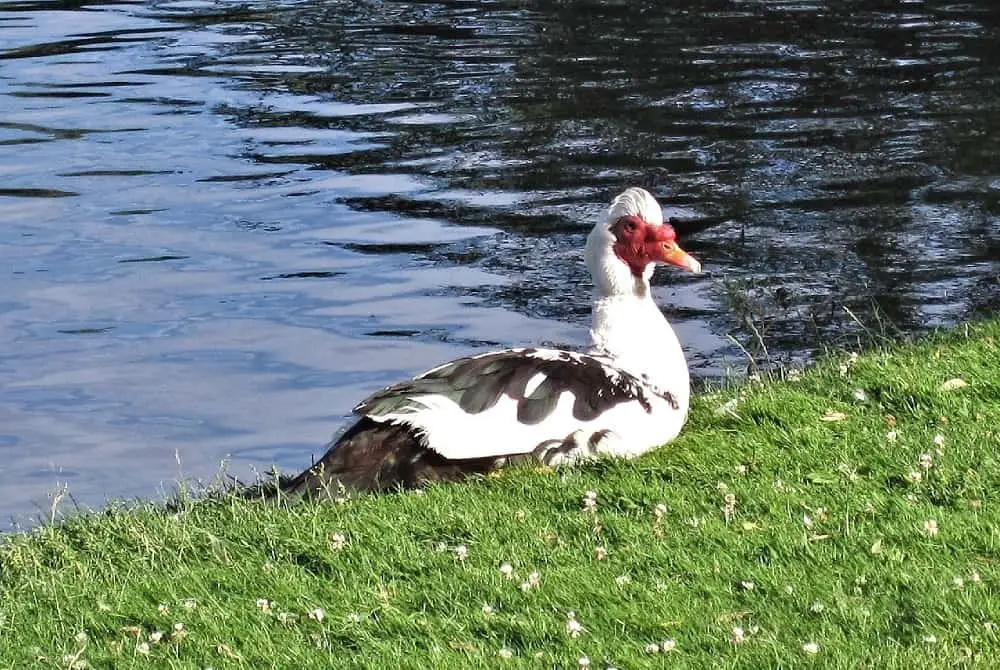- Where are the roseate spoonbills in Florida?
They can be found in the southern part of Florida, including Miami and the Keys.
- How rare is a Roseate Spoonbill?
The greatest variety of bird species can be found in Texas, with over 3 thousand pairs nesting there. Louisiana and Florida also have their own populations that number about 1,500 each; however, these numbers pale compared to those seen during springtime when long-distance wanderers tend to come into the state.
If you love birds, you should consider visiting the state of Florida to see roseate spoonbills in their natural habitat.
Roseate spoonbills are stunning pink wading birds that can be found in Florida and other parts of the southeastern United States.
These beautiful birds get their distinctive color from the food they eat – crustaceans and other aquatic invertebrates. Roseate spoonbills use their long, spoon-shaped bills to filter food from the water as they wade through marshes and wetlands.
These fascinating birds are a joy to watch, and they play an important role in the ecosystem by helping to control populations of aquatic insects and other animals.
In this article, we’ll talk about their Behavior, Habitat, and Conservation. You might be surprised at just how common these birds are.
Read on to learn more about this migratory bird! It’s a great bird to watch and take photos of!
Why Are Roseate Spoonbills Pink?
There are several reasons why roseate spoonbills are pink, but the most basic one is their diet. The bird gets their pink color from the carotenoids they ingest.
These are found in crustaceans, algae, and other aquatic invertebrates.

To obtain their pink color, spoonbills must consume more of these pigments. There are six species of spoonbills, including the roseate spoonbill.
They are large wading birds that roost in marshes and lakes. The chicks of spoonbills are born with a straight beak, and the spoon shape develops as they grow.
The male of the species uses gifts like nesting material to attract the female to mate. They stay monogamous once mated, taking turns sitting on the female’s egg and feeding the young.
A roseate spoonbill is a rare sight in the wild.
The pink feathers on its neck make it easy to spot from a distance.
The large spatula-shaped bill of the roseate spoonbill helps it find food in shallow water.
This bird uses its sensitive nerve endings in its bill to probe the bottom of the water.
They also eat shrimp, crabs, slugs, and crayfish. But there is another theory behind why they are pink: they may be eating toxic algae in their habitat.
A study from the Wildlife Conservation Society suggests that this color is caused by an algae bloom.
The roseate spoonbill breeds in colonies, where males and females pair off during the breeding season. Female spoonbills lay one to five eggs, which are incubated by both parents.
The young are partially feathered and have a slight pink tinge on their wings. At about one month of age, the chick starts to exercise, clambering through the foliage.
They reach full maturity at two to three years old.
In addition to its unusual color, the roseate spoonbill’s diet contains abundant amounts of carotenoids.
These compounds are responsible for the pink color of the bird’s plumage. The roseate spoonbill lives in brackish waters and feeds almost exclusively on aquatic invertebrates.
The roseate spoonbills are members of a group of birds called the “bowl of spoonbills”.
Though the number of breeding pairs of the roseate spoonbill has recovered to a point where it no longer requires special conservation status, scientists are still worried about the birds’ decline.
The reduction in their numbers may be the result of pesticide use and degradation of their natural habitat.
The species’ habitat has been destroyed for centuries, but preservation efforts have allowed them to return to Florida and Texas coasts, and they are slowly spreading across the coastal Southeast.
Due to conservation efforts, the number of spoonbills has recovered.
They were nearly eradicated from the United States in the early 1900s due to hunting for their feathers. As a result, the population declined to only thirty breeding pairs, and extinction seemed imminent in the United States.
However, thanks to conservation efforts, they have recovered and are now found throughout the United States. These colorful birds are once again nesting in coastal marshes.
Male vs Female Roseate Spoonbills
This beautiful bird is an excellent example of how gender differences can affect bird behavior.
The biggest difference between a male and a female Roseate Spoonbill is the bill.
The female’s bill is a lot longer than the male’s, so it’s much easier to detect when a male is near. The males extend their wings and may even bite each other’s bills.
While they don’t typically stay together for long, they often remain paired throughout the breeding season.
In terms of appearance, the male is slightly larger than the female.
The female is more colorful, but her head is darker. The male possesses a darker plumage. This coloration is often the result of a more sexy pattern.
Moreover, the roseate spoonbills are very social birds. They live in colonies with other spoonbills, ibises, herons, and egrets.
The roseate spoonbill’s male is about 28 inches long and has a 53-inch wingspan.
It has a rounded head with a long neck and a long, spatula-like bill. It also has bright red eyes. The female has pink wing shoulders during the breeding season.
Both males and females fly with their necks outstretched and alternate between fast, shallow wingbeats and glides.
Roseate spoonbills are among the least endangered species on the IUCN Red List. Though the species is stable, they are still under threat from habitat loss.
In the 1800s, these birds were hunted for their feathers.
Egret feathers were used to make luxury ladies’ garments. The resulting awareness eventually led to the protection of their habitat in the mid-1940s.
Today, these birds are protected by the US Migratory Bird Treaty Act.
The roseate spoonbill’s nesting habitats are mixed colonies near other wading birds.
While most of them nest along the coast, some also breed on inland islands. Coastal mangroves and dredged-up islands are ideal nesting habitats for roseate spoonbills.
The female lays up to three eggs, which are incubated by both adults. Both parents feed the young.
Roseate spoonbills live in swampy areas and feed by sweeping their spoon-shaped bills through the water. Unlike most other spoonbills, these birds can survive in freshwater and salty environments.
They use their slick bill to pick up insects and fish and sift through the mud.
While feeding, roseate spoonbills feed their young and are monogamous once they’ve mated.
Its spatula-shaped beak makes it the only pink spoonbill species in the western hemisphere. Spoonbills are found in the Merritt Island National Wildlife Refuge and Indian River Lagoon National Estuary.
However, in most parts of the world, it is the male roseate spoonbill that is more common.
The Spoonbill Beak
If you’re familiar with the shape of the spoonbill beak, you’ll love this bird’s unique look. Its short, straight bill is reminiscent of a spoon, and its rounded bill will mature over time.
While the adult spoonbill has a very distinctive bill, the beak of the spoonbill chick is short and straight.
The chick’s bill remains straight for a few weeks after its family leaves the nest, but as it matures, it takes on a spoonbill shape.
The beak of a spoonbill resembles a spatula or a spoon.
It is several inches long and narrows toward the end. These birds feed on many different types of aquatic animals and fish.
Despite their opportunistic feeding habits, the spoonbill is vulnerable to human interaction. Prior to regulation, humans hunted spoonbills extensively.
Their beaks are nearly an inch from the bottom of the water.
A spoonbill can be distinguished by its pink plumage.
Other Spoonbill species have white plumage.
The pink color comes from shrimp and other invertebrates.
Both male and female Spoonbills can raise their crests in mating displays and have a 120-cm wingspan. Their white breast and white patches above their eyes and in the middle of their foreheads are visible in flight.
While the Roseate Spoonbill can live in fresh and brackish waters, it prefers shallow wetlands.
Its distinctive spatula-shaped bill enables it to sift through the water with ease, and it uses its touch receptors to feel and grasp prey.
The bird’s pink color is actually derived from its diet, which is made up of various species of algae and crustaceans.
Population trends of the Roseate Spoonbill in Florida
The roseate spoonbill is one of Florida’s most beautiful birds. It is the only spoonbill native to the Western Hemisphere.
Its pink-red wings, pinkish legs, and white neck and back make it look striking.

Males and females are nearly identical, except for the color of their bill.
The pink-red color of the roseate spoonbill’s feathers is derived from the carotenoids found in the organisms they eat.
While the species was once widespread in Florida, the continued persecution that it has suffered has resulted in its decline.
By the 1940s, the species was relegated to nesting only in South Florida, southwestern Louisiana, and the Texas Gulf Coast. Although its numbers are now increasing, they remain a species of concern in Florida.
As such, you must be careful not to disturb nesting grounds.
Roseate Spoonbills in Florida Habitat
A species of wading bird, the Roseate Spoonbill often mingles with other wading birds in shallow water, but it is easily distinguishable because of its pink body, crimson shoulder feathers, and orangey tail.
They are often mistaken for flamingos in the distance.
The bird is also recognizable by its lead-colored head and large, wide-tipped spatulate bill.
Though the species is found throughout Florida, it also inhabits parts of Louisiana and Texas.
During the breeding season, entire flocks may suddenly circle the area.
Males present sticks to females, and females accept them by shaking them with their beaks. The male then perches next to the female, and they begin nest building.
During the nest-building season, spoonbills nest in mudflats and mangrove keys.
Conservation biologists are looking for ways to protect and restore this species’ habitat.
They are taking a step forward every day to help the birds find new places to breed and eat. While this may seem like a small improvement, it is only a new chapter in an old, troubling story.
Despite their efforts, they still face a number of challenges, including changing climate and food sources, and pressures to evolve.
Roseate Spoonbills in Florida Behavior
In addition to its wide range, the roseate spoonbills in Florida are popular birds to see, where it is found on both islands and inland wetlands.
These birds have a preference for freshwater over salt water, and their limited ability to deal with hyperosmotic prey makes them an attractive choice for birdwatching. These birds also nest in dense vegetation above the ground and usually near water.
Roseate spoonbills are monogamous during the breeding season and help raise their young.
In some areas, male spoonbills may use territorial defense tactics to protect the nesting site.
Males will display a threat posture and chase other spoonbills, but the females are only interested in defending their nests.
While they may appear aggressive to visitors, roseate spoonbills can also be submissive, displaying behaviors that make them an excellent target for wildlife photographers.
Conservation of Roseate Spoonbills in Florida

The Roseate Spoonbill is a critically endangered species, and conservation efforts in Florida are aimed at protecting their nesting grounds.
The species is colonial, meaning that they nest in a group with many other wading birds. Historically, the bird was hunted for its feathers, which were then used in hats and decorative screens.
Today, however, the species faces threats from habitat degradation, illegal shootings, and pesticides.
Fortunately, the spoonbill is protected under Florida and U.S. Endangered Species Rule.
The species’ habitat is highly vulnerable to sea-level rise.
While its mobility allows it to migrate from its habitat, sea-level rise threatens its home habitat.
As sea levels rise, a large portion of mangrove habitat is expected to flood. As a result, natural mangrove expansion in Florida may conflict with human land uses, affecting this bird’s ability to feed and reproduce.
Additionally, altered salinity levels in Florida may affect the quality and quantity of prey for spoonbills.
Are Roseate Spoonbills Rare in Florida?
Yes, roseate spoonbills are fairly rare in Florida.
They’re most commonly found in South America, but can also be found in parts of Central America, the Caribbean, and the southernmost United States.
In Florida, they’re most often seen in the Everglades and along the Gulf Coast.
While their numbers have been increasing in recent years, they’re still considered a species of concern due to habitat loss and degradation.
Are spoonbills protected in Florida?

Yes, spoonbills are protected in Florida. The state of Florida has listed the roseate spoonbill as a threatened species since 1975.
In addition, the U.S. Fish and Wildlife Service has designated portions of Florida’s coastline as critical habitats for the species.
This means that there are special protections in place for these areas in order to help ensure the survival of the spoonbill population.
Are Spoonbills Endangered?
So, are spoonbills endangered? Well, that depends on your point of view.
While a high percentage of spoonbills are considered threatened by the IUCN, some of these species are experiencing sustained population growth.
Unfortunately, the plume hunters have almost eliminated these birds from their habitats, and they have experienced a sharp decline in numbers.
In addition to destroying nest sites, spoonbills are also threatened by habitat loss. In North America, the species nests in colonies.
In addition to nesting with other wading birds, their feathers are used in decorative screens and hats. Hunters also targeted the fine plumes of breeding egrets and destroyed the nest sites of the species.
Because of their widespread habitat loss, spoonbills are threatened by invasive species, human disturbances, and pesticides.
Wrapping Up…
The roseate spoonbills in Florida are a great addition to any nature lover’s backyard. These birds are known for their long, curved bills and pink plumage.
Roseate spoonbills use their bills to sweep through the water in search of food. Their diet consists of small fish, crustaceans, and insects. Roseate spoonbills are social creatures and can often be seen in large groups.
They nest in trees or shrubs near bodies of water. Roseate spoonbills are an important part of the ecosystem in Florida.
They help to control the populations of small fish and crustaceans.
They also provide food for other animals such as snakes and alligators. Roseate spoonbills are a beautiful sight in Florida and are sure to bring enjoyment to any birdwatcher.








